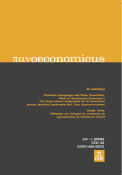The Relationship Between Public Debt and Income Inequality in Advanced and Developing Economies: Empirical Evidence on the Difference
DOI:
https://doi.org/10.2298/PAN211221001NKeywords:
Public debt, Income inequality, Advanced economies, Developing economies, System GMM estimator, PMG estimatorAbstract
In the context of increasing globalization, income inequality becomes one of the severe problems in both advanced and developing economies. Meanwhile, public spending financed by public debt may be an appropriate instrument of fiscal policy to narrow this inequality in society. However, high public debt can lead to an economic crisis and social instability. Does public debt differently affect income inequality between advanced and developing economies? For the answer, the paper applies the two-step system GMM Arellano-Bond estimator and the PMG estimator to test the effect of public debt on income inequality for a group of 30 advanced economies and a group of 34 developing economies between 2002 and 2020. The paper notes some exciting results. First, public debt narrows income inequality in advanced economies but widens it in developing economies. Second, by contrast, economic growth increases income inequality in advanced economies but decreases it in developing economies. Third, unemployment in advanced economies and education in developing economies enhance income inequality. These findings suggest some policy implications for governments in developing economies in using appropriately spending financed by public debt to narrow income inequality in society.
JEL: D31, E24, H63






